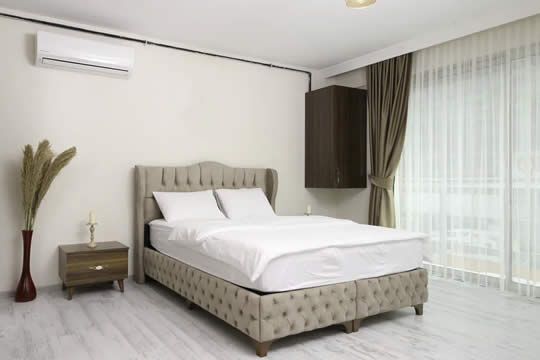Air Conditioning Systems: The Different Types Explained
There are a number of different types of air conditioner, with each best suited for different applications and in this article the air conditioning systems are explained.
This guide can help you to find the best place to start if your looking to buy an air conditioning solution for your home or office space.
I will explain things to help you understand the basics of all major air conditioner types that are commonly available.
 These are some of the most commonly found types:
These are some of the most commonly found types:
- Central air systems
- Multi-head mini-split units
- Window units
- Portable units
There are many options for air conditioners, and each one is unique and can have different quality features.
A modern, efficient multi head split unit may be more efficient that an older central system, depending on age and how well it was maintained throughout its operating life.
The energy rating system is an excellent way to compare energy use for air conditioners. However, you can find more information by looking at their capacity outputs as well as inputs.
Central Air Conditioning
Central air conditioning is also called ducted or ventral air and is designed to both cool the building in summer and heat it in winter.
This kind of system can be extremely efficient in many circumstances.
A ducted air conditioning system is comprised of an external compressor, an internal unit for evaporative cooling and ducts that distribute conditioned heat through the rooms.
Should you decide to install a ducted system, you should be aware that it will require some significant modifications to your home and can have a high initial cost.
These systems are great at controlling the temperature of an entire home or office. And they can often be less expensive to install than many mini-splits systems or multiple individual window units.
The compressor is required on the outside of the building for these central air systems, but they are virtually inaudible inside. Central air conditioners are generally the most efficient for a variety of situations.
Split Air Conditioners Wall Hung or Multi Head Split
These ductless systems have become very common in modern houses. These systems are also called split or mini-split AC systems.
This is because there are two units inside your home and one outdoors. They can cool or heat one area or be used in multi-zone systems.
They combine an outdoor compressor with multiple indoor units to regulate the airflow in your home.
The indoor units are typically mounted high on the walls. This makes it important to account them when planning your space. Multi head split and wall-split systems tend to have smaller ducts and are often connected with piping. Despite this fact, indoor units can still be seen better than ductless vents.
Wall-hung split and multihead split systems have a greater upfront cost than other air conditioners. But, they are less expensive than ducted air conditioning. They are generally more efficient than portable or window units which means they are cheaper over the long-term.
For a wall-hung, split or multi-head system, you will need to modify your home in order to accommodate the piping. You will get the best from the system if you have a professional install it for you.
Single-Unit and Window Air Conditioners
These were a popular option to regulate the temperature in a small space. They include the compressor and condenser, the coils and the heat exchanger all in one unit.
Window air conditioners can fit inside a window. They don't require any major home modifications. Wall units are almost identical, but need to be installed through a hole in a wall.
Window air conditioners tend to be very affordable in the long-term. Split and ducted systems tend to be more efficient if you plan on cooling multiple rooms. Window air conditioners also have the advantage that they can be carried with you when you move.
These AC units are great for people renting an apartment and for those who intend only a short stay in any one place.
Similar to window AC units are the self contained AC devices known as Package Terminal Air Conditioners (PTAC) and Vertical Terminal Air Conditioners (VTAC).
These are enclosed AC systems that can be installed against an exterior wall without obscuring a window opening and reducing the amount of natural light entering a room. They vent through an opening in the wall, keeping things neat and tidy.
These units are more often found in hotel and motel rooms and some hospital and health center rooms.
Most single-unit and window conditioners operate on a cycle. This means that they are turned on to heat up or cool down the space, then switched off when they have reached the desired temperature.
Once the room is heated up or cooled again, they will turn themselves on and off once more heat or cold air enters the room. They aren't as efficient with energy as mini-split systems but offer a means of keeping cool in summer when no other fixed cooling system is available.
Portable Air Conditioners
For those looking for the most simple cooling solution, portable air conditioners are perfect for use in different locations and don't take too much effort to transport.
Think of portable air conditioners as easier to move around than they are to bring with you to cool your home.
While they are smaller than other units, they are still more portable. However, they need to have a window installation kit.
These systems use warm air to cool the room and then draw it in. There are two main types, single and dual-hose AC models.
Single Hose vs Dual Hose
Single ducts draw heat from the inside of the room, cool it, and return it back to the room. This creates negative air pressure in the room, and warms the room by bringing in more heat from outside and the rest.
Due to this reason, single hose models prove inefficient.
Some portable air conditioners have an additional hose to draw outside air and these are generally known as dual-hose AC units. Double ducts use one to draw air from outside to cool and the other to vent the hot air produced by the refrigeration process outside.
This reduces the negative effects of single duct models. Despite this, double-hose models are still more efficient than single-hose types.
There are also self-evaporating portable AC units that have better efficiency since they recycle the moisture than condenses inside the unit to aid the cooling process before being re-evaporated and exhausted out the vent hose. As such, these units do not need to be drained as often as regular portable units do.
Portable air conditioners typically have very low initial (purchase) cost when compared with other cooling devices. These coolers are more expensive to operate than other options in the long-term.
You should look into other models if your home is not mobile, has limited cooling, or you plan on using the appliance very rarely.
Summary
As you can see from the above, there are many options for air conditioners. They all have different uses.
While ducted central AC is generally the most efficient option overall, it won't suit everyone's needs and can be unnecessary when you only need to cool down or heat up a single room.
The best rule of thumb is that if you're looking for an air conditioning solution for your home or workspace, first figure out what type best suits your situation and budget. Next, choose the type that is most suitable for you and your particular heating and cooling needs and circumstance.
[BACK TO TOP]
